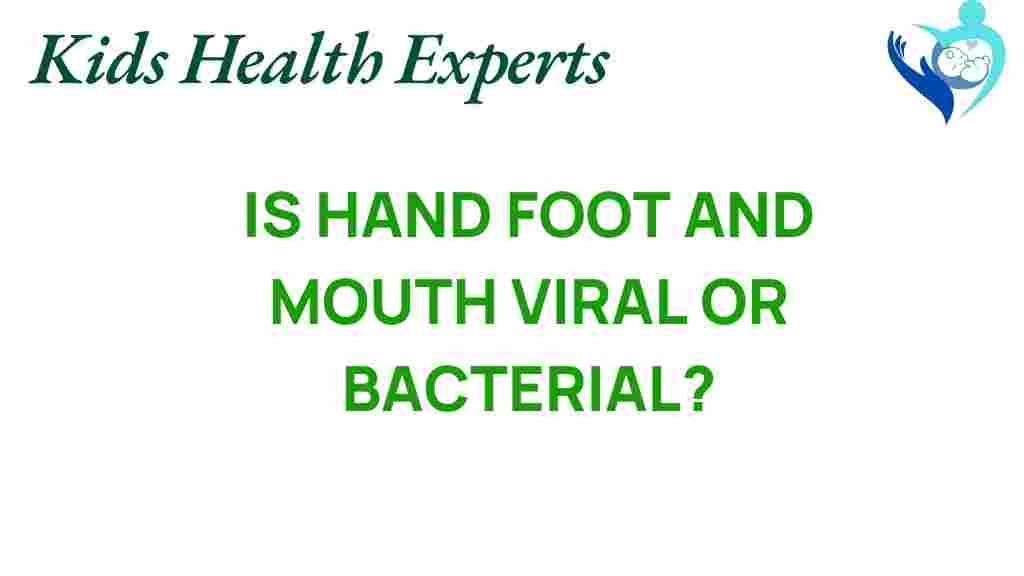Is Hand Foot and Mouth Disease Viral or Bacterial? Understanding Hand Foot and Mouth Disease
Hand Foot and Mouth Disease (HFMD) is a common viral infection that primarily affects children under five years old, although it can also occur in older children and adults. This illness is characterized by fever, mouth sores, and a rash on the hands and feet. In this article, we will explore whether Hand Foot and Mouth Disease is a viral or bacterial infection, discuss its symptoms, treatment options, preventive measures, and its contagious nature.
What Causes Hand Foot and Mouth Disease?
Hand Foot and Mouth Disease is primarily caused by viruses from the Enterovirus genus, particularly the Coxsackievirus. This viral infection is not caused by bacteria, which helps to clarify the confusion surrounding its classification. The most common strains that lead to HFMD include:
- Coxsackievirus A16
- Coxsackievirus A6
- Enterovirus 71
These viruses thrive in the gastrointestinal tract and can be spread through direct contact with respiratory droplets, saliva, or fluid from blisters of an infected person. This makes HFMD highly contagious, especially in settings such as daycare centers and schools.
Symptoms of Hand Foot and Mouth Disease
The symptoms of Hand Foot and Mouth Disease typically appear 3 to 7 days after exposure to the virus. Common symptoms include:
- Fever
- Sore throat
- Painful sores in the mouth
- Rash on the hands and feet
- Loss of appetite
- Irritability in infants and toddlers
Symptoms usually last for a week, and while HFMD is generally mild, it can occasionally lead to more severe complications, especially in very young children or those with weakened immune systems.
Treatment for Hand Foot and Mouth Disease
Since Hand Foot and Mouth Disease is caused by a viral infection, antibiotics used to treat bacterial infections will not be effective. Treatment primarily focuses on relieving symptoms and ensuring comfort. Here are some recommended approaches:
- Hydration: Ensure the child drinks plenty of fluids to stay hydrated, especially if they have mouth sores that make swallowing painful.
- Pain relief: Over-the-counter medications, such as acetaminophen or ibuprofen, can help alleviate fever and discomfort.
- Mouth care: Use saltwater rinses or topical oral analgesics to soothe mouth sores.
- Soft foods: Offer soft, bland foods that are easy to swallow, avoiding spicy or acidic foods that may irritate mouth sores.
Most cases of Hand Foot and Mouth Disease resolve on their own without the need for medical intervention. However, if a child shows signs of dehydration, persistent high fever, or severe symptoms, it is essential to consult a healthcare provider.
Preventing Hand Foot and Mouth Disease
Preventing Hand Foot and Mouth Disease is crucial to controlling its spread, particularly in communal settings. Here are effective prevention strategies:
- Hand hygiene: Encourage frequent handwashing with soap and water, especially after using the bathroom and before eating.
- Disinfect surfaces: Regularly clean and disinfect frequently-touched surfaces and toys.
- Avoid close contact: Keep infected children away from others until they are no longer contagious.
- Stay home when sick: Keep children at home during outbreaks or if they exhibit symptoms of HFMD.
By implementing these preventive measures, the risk of contracting or spreading Hand Foot and Mouth Disease can be significantly reduced.
Is Hand Foot and Mouth Disease Contagious?
Yes, Hand Foot and Mouth Disease is highly contagious. The virus can spread through:
- Direct contact with an infected person’s bodily fluids, such as saliva, mucus, or fluid from blisters.
- Touching surfaces or objects contaminated with the virus.
- Close personal contact, such as hugging or kissing an infected person.
Children are particularly susceptible to HFMD due to their close interactions in places such as homes, schools, and daycare centers. The virus can be present in an infected person’s body for days before symptoms appear, making it challenging to prevent its spread completely.
Troubleshooting Tips for Parents and Caregivers
As a parent or caregiver, managing a child with Hand Foot and Mouth Disease can be challenging. Here are some troubleshooting tips to help navigate through this illness:
- Monitor symptoms: Keep track of your child’s symptoms and inform a healthcare provider if they worsen or do not improve.
- Maintain comfort: Use cool compresses to soothe fever and discomfort. Create a comfortable environment for rest and recovery.
- Encourage rest: Ensure the child gets plenty of sleep and rest, as this aids in recovery from the viral infection.
- Stay informed: Keep updated with reliable health resources or consult with your pediatrician for guidance on managing HFMD.
Conclusion
In summary, Hand Foot and Mouth Disease is a viral infection, caused primarily by the Coxsackievirus, and is highly contagious among children. Understanding its symptoms, treatment options, and prevention strategies can equip parents and caregivers to effectively manage this common illness. By practicing good hygiene and maintaining awareness, we can help reduce the spread of Hand Foot and Mouth Disease and ensure the well-being of our children.
For further reading on viral infections, you can visit CDC’s website for the latest updates. If you have concerns about your child’s health, consult your healthcare provider for personalized advice.
If you’re looking for more information on common childhood illnesses, check out our comprehensive guide here.
This article is in the category Conditions and created by KidsHealthExperts Team
